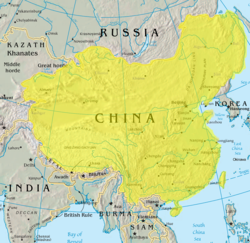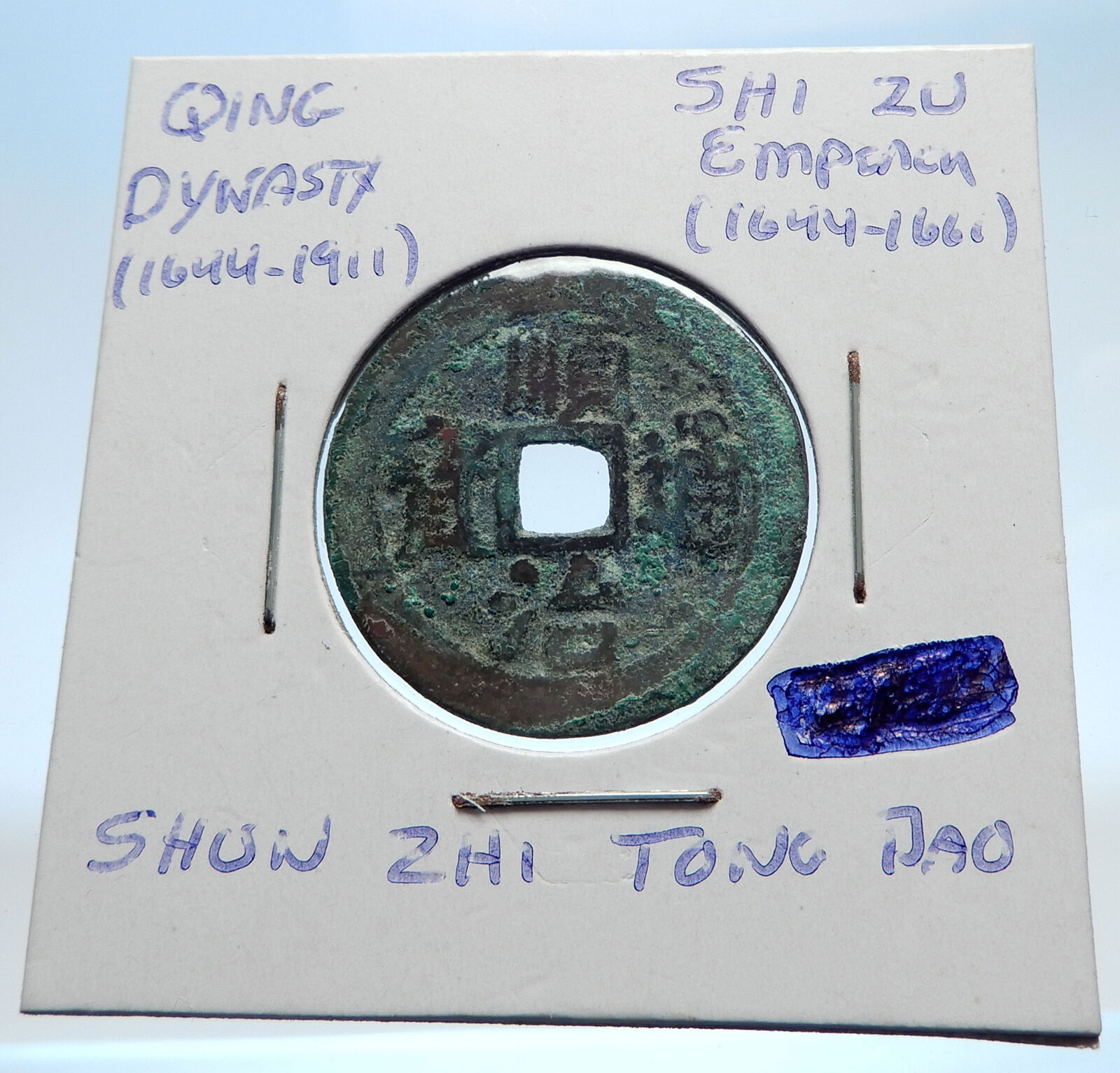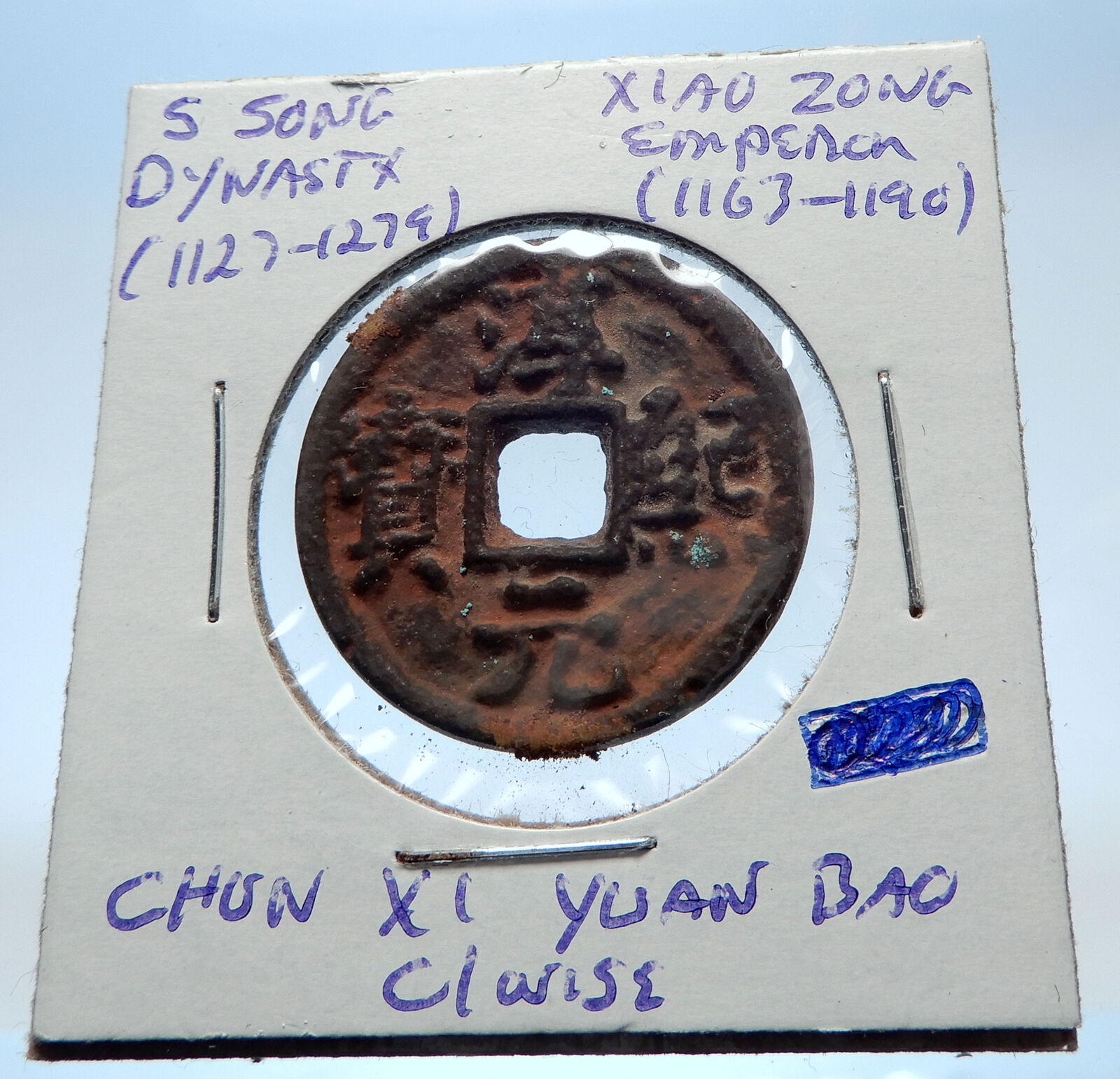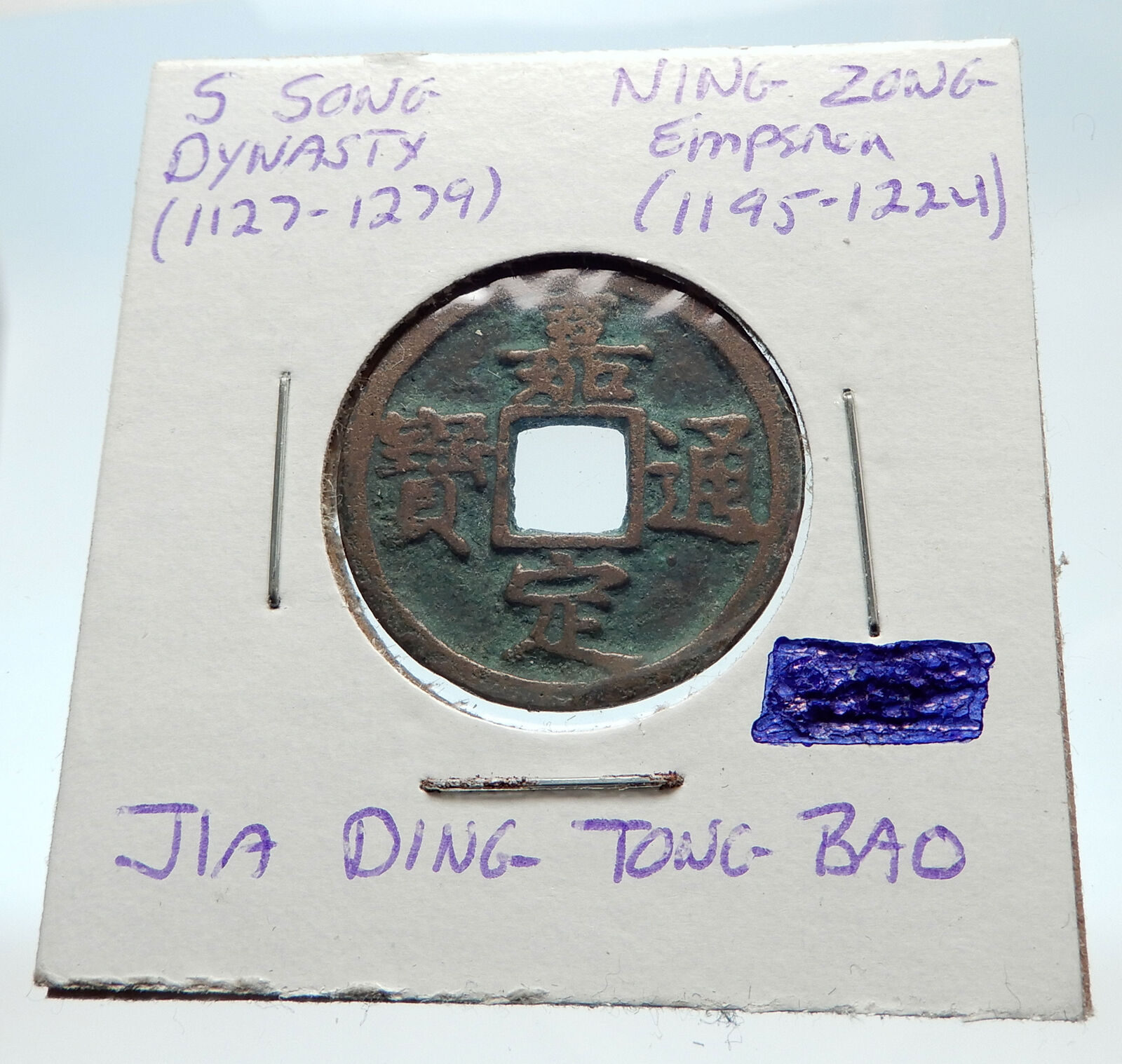|
China – Qing Dynasty (1644-1912 A.D.)
Shi Zu (Shunzhi) – Emperor: 1644-1661 A.D.
Bronze Shun Zhi Tong Bao Cash Token 26mm, Struck 1644-1661
Reference: H 22.81
Chinese symbols.
Je, Zhe, Hangzhou, Zhejiang.
You are bidding on the exact item pictured, provided with a Certificate of Authenticity and Lifetime Guarantee of Authenticity.
 The Shunzhi Emperor (15 March 1638 – 5 February 1661) was the third emperor of the Qing dynasty and the first Qing emperor to rule over China, from 1644 to 1661. A committee of Manchu princes chose him to succeed his father, Hong Taiji (1592-1643), in September 1643, when he was five years old. The princes also appointed two co-regents: Dorgon (1612-1650), the 14th son of the Qing dynasty’s founder Nurhaci (1559-1626), and Jirgalang (1599-1655), one of Nurhaci’s nephews, both of whom were members of the Qing imperial clan. The Shunzhi Emperor (15 March 1638 – 5 February 1661) was the third emperor of the Qing dynasty and the first Qing emperor to rule over China, from 1644 to 1661. A committee of Manchu princes chose him to succeed his father, Hong Taiji (1592-1643), in September 1643, when he was five years old. The princes also appointed two co-regents: Dorgon (1612-1650), the 14th son of the Qing dynasty’s founder Nurhaci (1559-1626), and Jirgalang (1599-1655), one of Nurhaci’s nephews, both of whom were members of the Qing imperial clan.
From 1643 to 1650, political power lay mostly in the hands of Dorgon. Under his leadership, the Qing Empire conquered most of the territory of the fallen Ming dynasty (1368-1644), chased Ming loyalist regimes deep into the southwestern provinces, and established the basis of Qing rule over China despite highly unpopular policies such as the “hair cutting command” of 1645, which forced Qing subjects to shave their forehead and braid their remaining hair into a queue resembling that of the Manchus. After Dorgon’s death on the last day of 1650, the young Shunzhi Emperor started to rule personally. He tried, with mixed success, to fight corruption and to reduce the political influence of the Manchu nobility. In the 1650s, he faced a resurgence of Ming loyalist resistance, but by 1661 his armies had defeated the Qing Empire’s last enemies, seafarer Koxinga (1624-1662) and the Prince of Gui (1623-1662) of the Southern Ming dynasty, both of whom would succumb the following year. The Shunzhi Emperor died at the age of 22 of smallpox, a highly contagious disease that was endemic in China, but against which the Manchus had no immunity. He was succeeded by his third son Xuanye, who had already survived smallpox, and who reigned for sixty years under the era name “Kangxi” (hence he was known as the Kangxi Emperor). Because fewer documents have survived from the Shunzhi era than from later eras of the Qing dynasty, the Shunzhi era is a relatively little-known period of Qing history.
“Shunzhi” was the name of this ruler’s reign period in Chinese. This title had equivalents in Manchu and Mongolian because the Qing imperial family was Manchu and ruled over many Mongol tribes that helped the Qing to conquer China. The emperor’s personal name was Fulin, and the posthumous name by which he was worshipped at the Imperial Ancestral Temple was Shizu (Wade-Giles: Shih-tsu; Chinese: 世祖).
Cash was a type of coin of China and East Asia, used from the 4th century BC until the 20th century AD. Originally cast during the Warring States period, these coins continued to be used for the entirety of Imperial China as well as under Mongol, and Manchu rule. The last Chinese cash coins were cast in the first year of the Republic of China. Generally most cash coins were made from copper or bronze alloys, with iron, lead, and zinc coins occasionally used less often throughout Chinese history. Rare silver and gold cash coins were also produced. During most of their production, cash coins were cast but, during the late Qing dynasty, machine-struck cash coins began to be made. As the cash coins produced over Chinese history were similar, thousand year old cash coins produced during the Northern Song dynasty continued to circulate as valid currency well into the early twentieth century.
In the modern era, these coins are considered to be Chinese “good luck coins”; they are hung on strings and round the necks of children, or over the beds of sick people. They hold a place in various superstitions, as well as Traditional Chinese medicine, and Feng shui. Currencies based on the Chinese cash coins include the Japanese mon, Korean mun, Ryukyuan mon, and Vietnamese văn.
The Qing dynasty, also known as the Qing Empire, officially the Great Qing, was the last imperial dynasty of China, established in 1636 and ruling China from 1644 to 1912. It was preceded by the Ming dynasty and succeeded by the Republic of China. The Qing multi-cultural empire lasted almost three centuries and formed the territorial base for the modern Chinese state. It was the fourth largest empire in world history.

Qing Empire, 1765
The dynasty was founded by the Jurchen Aisin Gioro clan in Manchuria. In the late sixteenth century, Nurhaci, originally a Ming vassal, began organizing “Banners”, military-social units that included Jurchen, Han Chinese, and Mongol elements. Nurhaci formed the Jurchen clans into a unified entity, which he renamed as the Manchus. By 1636, his son Hong Taiji began driving Ming forces out of Liaodong and declared a new dynasty, the Qing. In 1644, peasant rebels led by Li Zicheng conquered the Ming capital, Beijing. Rather than serve them, Ming general Wu Sangui made an alliance with the Manchus and opened the Shanhai Pass to the Banner Armies led by the regent Prince Dorgon, who defeated the rebels and seized the capital. Resistance from the Southern Ming and the Revolt of the Three Feudatories led by Wu Sangui delayed the Qing conquest of China proper by nearly four decades. The conquest was only completed in 1683 under the Kangxi Emperor (r. 1661-1722). The Ten Great Campaigns of the Qianlong Emperor from the 1750s to the 1790s extended Qing control into Inner Asia. The early Qing rulers maintained their Manchu customs, and while their title was Emperor, they used “Bogd khaan” when dealing with the Mongols and they were patrons of Tibetan Buddhism. They governed using Confucian styles and institutions of bureaucratic government and retained the imperial examinations to recruit Han Chinese to work under or in parallel with Manchus. They also adapted the ideals of the tributary system in dealing with neighboring territories.
During the Qianlong reign (1735-96) the dynasty reached its apogee, but then began its initial decline in prosperity and imperial control. The population rose to some 400 millions, but taxes and government revenues were fixed at a low rate, virtually guaranteeing eventual fiscal crisis. Corruption set in, rebels tested government legitimacy, and ruling elites failed to change their mindsets in the face of changes in the world system. Following the Opium War, European powers imposed “unequal treaties”, free trade, extraterritoriality and treaty ports under foreign control. The Taiping Rebellion (1850-64) and the Dungan Revolt (1862-77) in Central Asia led to the deaths of some 20 million people, most of them due to famines caused by war. In spite of these disasters, in the Tongzhi Restoration of the 1860s, Han Chinese elites rallied to the defense of the Confucian order and the Qing rulers. The initial gains in the Self-Strengthening Movement were destroyed in the First Sino-Japanese War of 1895, in which the Qing lost its influence over Korea and the possession of Taiwan. New Armies were organized, but the ambitious Hundred Days’ Reform of 1898 was turned back in a coup by the conservative Empress Dowager Cixi. When the Scramble for Concessions by foreign powers triggered the violently anti-foreign “Boxers”, the foreign powers invaded China, Cixi declared war on them, leading to defeat and the flight of the Imperial Court to Xi’an.
After agreeing to sign the Boxer Protocol, the government initiated unprecedented fiscal and administrative reforms, including elections, a new legal code, and abolition of the examination system. Sun Yat-sen and other revolutionaries competed with reformist monarchists such as Kang Youwei and Liang Qichao to transform the Qing Empire into a modern nation. After the deaths of Cixi and the Guangxu Emperor in 1908, the hardline Manchu court alienated reformers and local elites alike by obstructing social reform. The Wuchang Uprising on October 11, 1911, led to the Xinhai Revolution. General Yuan Shikai negotiated the abdication of Puyi, the last emperor, on February 12, 1912. The Qing Empire was briefly restored on July 1, 1917, before it was once again overthrown 12 days later.
|





 The Shunzhi Emperor (15 March 1638 – 5 February 1661) was the third emperor of the Qing dynasty and the first Qing emperor to rule over China, from 1644 to 1661. A committee of Manchu princes chose him to succeed his father, Hong Taiji (1592-1643), in September 1643, when he was five years old. The princes also appointed two co-regents: Dorgon (1612-1650), the 14th son of the Qing dynasty’s founder Nurhaci (1559-1626), and Jirgalang (1599-1655), one of Nurhaci’s nephews, both of whom were members of the Qing imperial clan.
The Shunzhi Emperor (15 March 1638 – 5 February 1661) was the third emperor of the Qing dynasty and the first Qing emperor to rule over China, from 1644 to 1661. A committee of Manchu princes chose him to succeed his father, Hong Taiji (1592-1643), in September 1643, when he was five years old. The princes also appointed two co-regents: Dorgon (1612-1650), the 14th son of the Qing dynasty’s founder Nurhaci (1559-1626), and Jirgalang (1599-1655), one of Nurhaci’s nephews, both of whom were members of the Qing imperial clan. 





